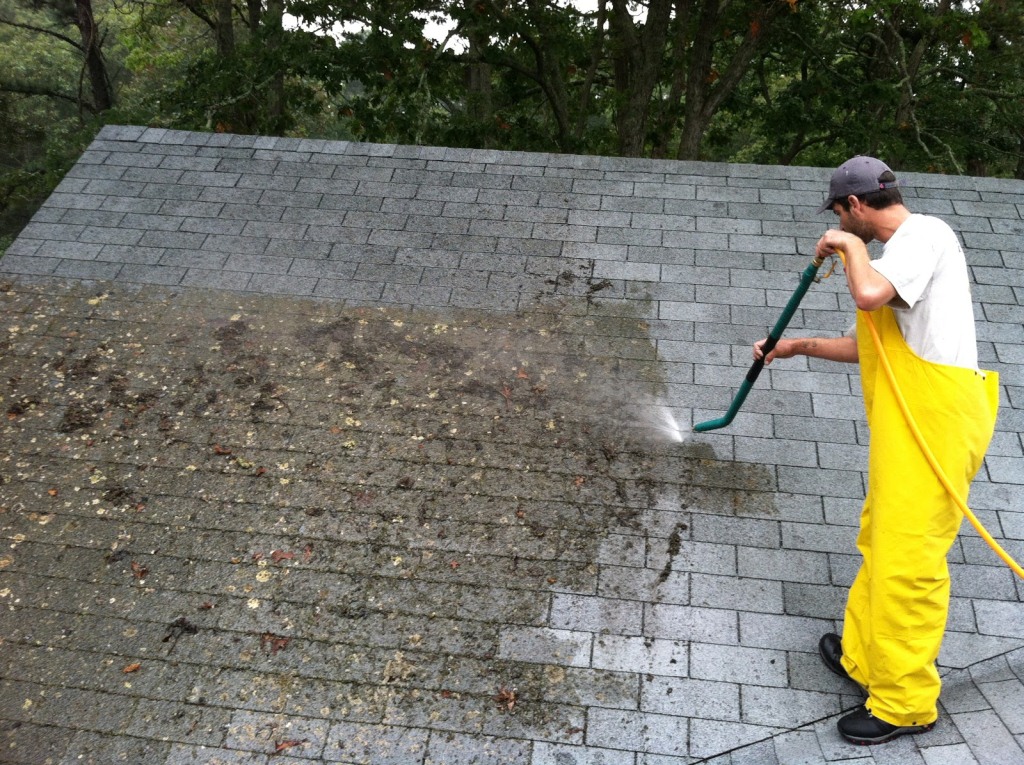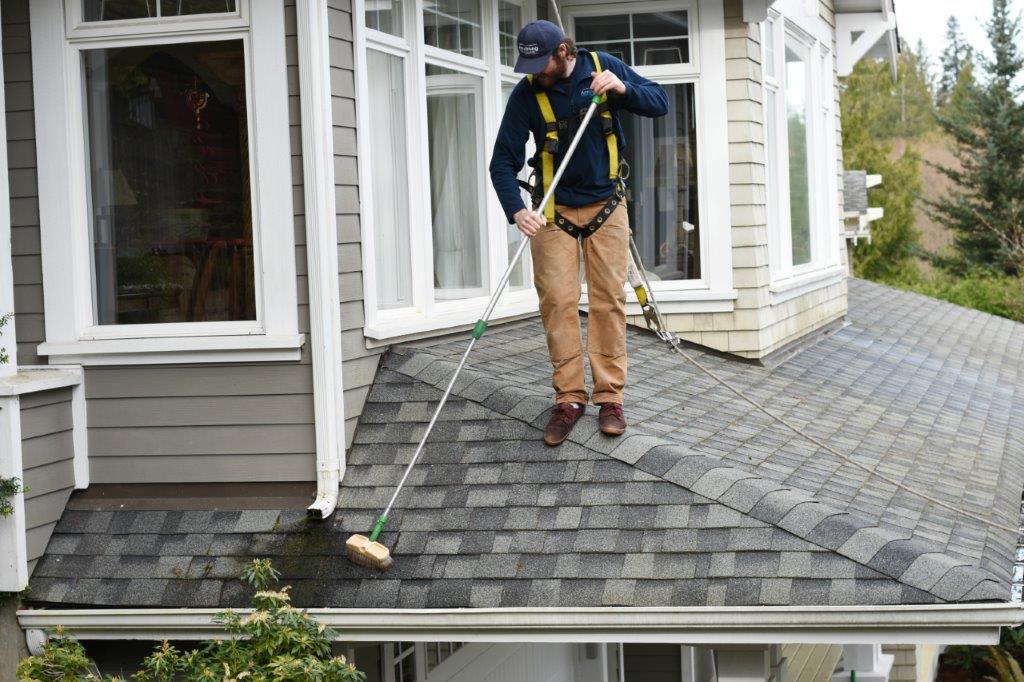A Comprehensive Guide to Roof Moss Elimination for each Property Owner
If you've discovered spots of environment-friendly on your roof covering, you're not alone. Moss can grow in damp problems, leading to prospective concerns for your home. Disregarding it could seem simpler, yet the consequences can be substantial. In this guide, you'll reveal effective methods for removal and discover how to avoid moss from returning. Comprehending these variables can conserve you money and time in the future, so let's explore what you require to recognize.
Comprehending Moss: What It Is and Why It Grows on Roofings
While you could not think much concerning it, moss is a typical problem on roofings, specifically in shaded or damp locations. Moss holds moisture versus your roof covering materials, which can create rot and deterioration over time.
You'll usually discover it growing in locations where sunshine is limited, such as north-facing inclines or below looming trees. If your roof covering has a great deal of natural debris like fallen leaves, it develops an excellent breeding ground for moss. Comprehending how moss spreads and grows is essential for reliable avoidance and removal. By remaining positive and dealing with wetness concerns, you can safeguard your roof and lengthen its life-span. Bear in mind, very early treatment is essential to keeping your roof in top shape.

Recognizing Moss Versus Various Other Roof Growths
When it involves your roof, distinguishing moss from various other growths is vital for effective upkeep. You'll typically come across algae, lichen, and other kinds of greenery, each requiring different treatments. Knowing exactly how to recognize moss can conserve you time and help safeguard your roof's honesty.
Common Roofing System Growth Types
Determining the different types of growth on your roof is vital for reliable maintenance, as different microorganisms can considerably influence your roofing system's health. While all these developments can harm your roof covering, acknowledging them aids you figure out the appropriate elimination techniques. Keep cautious, and inspect your roof on a regular basis to protect against major concerns down the line.

Moss Recognition Tips
To effectively identify moss from various other roofing growths, look very closely at its structure and shade. Moss generally looks like a soft, green cover, resembling a carpeting, and commonly feels squishy to the touch. It grows in wet, shaded areas, while various other growths like lichen can be crusty and may reveal a series of colors, including yellow or gray. Algae, on the various other hand, typically presents as dark touches or spots and can appear slimy when wet. Focus on the growth pattern; moss has a tendency to spread out evenly, while lichen and algae could develop irregular shapes. By observing these features, you can accurately identify moss and take the necessary steps for elimination.
The Dangers of Ignoring Moss on Your Roof Covering
Disregarding moss on your roof covering can lead to substantial structural damages and expensive repairs. When moss thrives, it traps wetness versus your shingles, accelerating decay and promoting leaks.
Additionally, moss can lift roof shingles, making them much more vulnerable to wind damage (Roof Moss Removal Nanaimo). You might believe it's simply a cosmetic issue, but those seemingly harmless green spots can cause severe architectural integrity concerns. You'll deal with not only repair expenses but also possible security risks for your household. if your roof weakens.
Overlooking moss isn't just an upkeep oversight; it can develop into an impending danger to your home's worth and your assurance. Remain alert and address moss immediately to safeguard your investment and stay clear of future headaches.
Effective Moss Elimination Techniques
Attending to moss on your roof covering is the first step in protecting your home from damage. This approach assists lessen damage while displacing the moss.
Following, take into consideration using a moss removal solution. You can make use of a store-bought item or develop a DIY blend of water and vinegar.
For persistent patches, a pressure washer can be efficient, but use it meticulously to avoid tile damages. Keep your roofing system tidy by trimming overhanging branches and ensuring appropriate water drainage. Routine upkeep can avoid moss from returning and keep your roofing system in top form.
Do It Yourself Moss Elimination vs. Employing a Specialist
While you might feel confident tackling moss removal on your own, evaluating the benefits of DIY techniques versus working with a professional can aid you make the finest option for your roof. DIY moss removal can save you money and give you a feeling of accomplishment.
Specialists have the devices and experience to eliminate moss effectively you could try this out and safely, lessening the threat of damage to your roof. They can also identify any kind of underlying issues that might require attention.
Preventative Measures to Keep Your Roof Covering Moss-Free

Take into consideration setting up zinc or copper strips along the roof ridge. Rainfall will certainly wash off steel fragments that hinder moss development. Additionally, utilize a biocide treatment particularly made for roofings to discourage moss and algae before they start.
Lastly, check your roof covering frequently for signs of moss or algae and resolve any problems right away. By taking these aggressive actions, you'll not just keep your roof looking wonderful however additionally prolong its life-span and avoid costly repairs in the future.
Maintenance Tips for Long-Lasting Roofing System Health And Wellness
Beginning by frequently evaluating your roof covering for damage, such as missing out on shingles or leakages. Trim overhanging branches to minimize particles buildup and reduce the threat of moss development.
If you notice substantial moss or algae, address it without delay to avoid damage. By adhering to these basic maintenance tips, you can keep your roofing system in top shape and prolong its lifespan significantly.
Regularly Asked Questions
How Commonly Should I Examine My Roof for Moss Development?
You ought to inspect your roofing for moss growth at the very least two times a year, ideally in spring and loss. Roof Moss Removal Nanaimo. Regular evaluations help catch any issues early, stopping prospective damage and guaranteeing your roof covering remains in great condition
Can Moss Damages My Roof Covering Shingles?
Yes, moss can harm your roof covering tiles. It catches moisture, bring about rot and wear and tear. If you discover moss, act swiftly to eliminate it and protect against further damages to your roofing's honesty and life expectancy.
What Weather Condition Issues Promote Moss Development on Roofs?
Moss prospers in damp, shaded settings with high moisture. If your roofing system gets little sunshine original site and experiences regular rainfall or haze, you're likely to see moss development, which can damage your shingles gradually.
Is It Safe to Walk on My Roofing While Removing Moss?
Strolling on your roofing system while eliminating moss can be high-risk. You need to examine for stability and avoid slippery surface areas. Constantly put on suitable footwear and consider making use of security gear to avoid mishaps during the process.
What Are the Long-Term Results of Roofing Moss on Home Worth?
Roofing moss can decrease your home's worth by creating a neglected appearance and possibly creating architectural damage. If left neglected, it may result in expensive fixings and discourage prospective customers from considering your residential property.
Disregarding moss on your click to investigate roof can lead to significant architectural damage and costly fixings.Resolving moss on your roofing is the initial action in safeguarding your home from damages. Professionals have the devices and experience to eliminate moss successfully and securely, reducing the threat of damage to your roof covering.Yes, moss can damage your roof tiles. If you discover moss, act promptly to remove it and prevent more damages to your roofing system's integrity and lifespan.